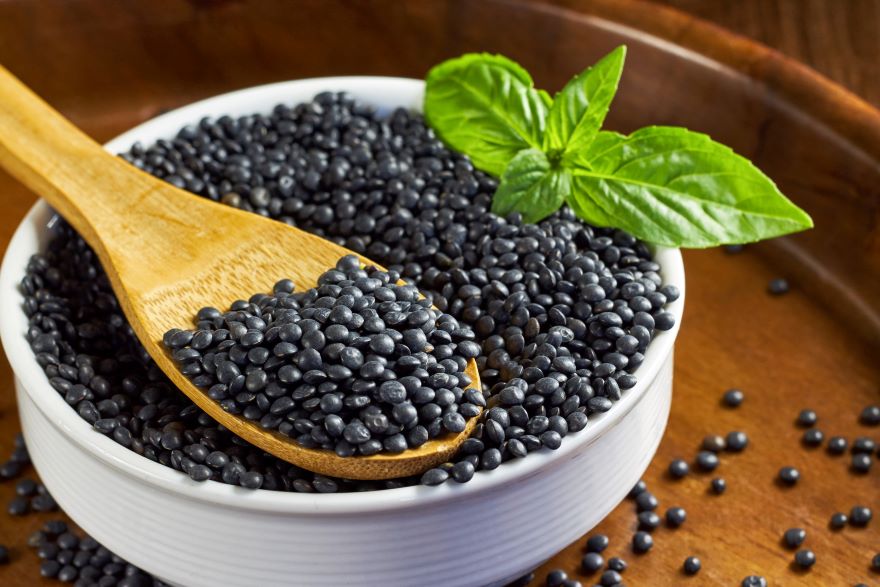- Black beluga lentils, often appreciated for their striking resemblance to caviar, are a unique variety of pulse known for their rich flavor and firm texture. These black lentils have garnered popularity not only for their visual appeal but also for their versatile use in kitchens worldwide. Their edible history dates back to ancient times and has since been a staple in many cultures for their ability to complement a variety of dishes ranging from soups to salads.

From a nutritional standpoint, black beluga lentils are an excellent source of plant-based protein, making them an ideal choice for vegan and vegetarian diets. Their health benefits extend beyond protein, as they are rich in fiber, minerals, and vitamins that are crucial to maintaining a balanced diet. When it comes to preparation, these lentils cook relatively quickly and retain their shape well, which makes them a breeze to use in a myriad of recipes that require minimal effort yet yield satisfying results.
Key Takeaways
- Black beluga lentils are versatile and nutritionally dense, ideal for a variety of dietary preferences.
- Their ease of cooking and ability to hold shape make them suitable for an array of culinary applications.
- As a staple food, they offer a considerable source of plant-based protein and other vital nutrients.
History and Origin of Black Beluga Lentils

Black beluga lentils are esteemed legumes with a rich history, tracing back to ancient Mediterranean civilizations. They are named for their resemblance to beluga caviar.
Cultivation and Varieties
Black lentils, also known as beluga lentils, have been cultivated around the Mediterranean for thousands of years. These small, shiny legumes are one of the many lentil varieties that have been nourishing humans for centuries. Notable for their earthy flavor and firm texture, beluga lentils have become a favorite ingredient in a variety of dishes.
Culinary Uses Worldwide
Beluga lentils have spread across the globe, gracing tables from Europe and Asia to the Middle East. Known for holding their shape well after cooking, these black lentils feature prominently in salads, soups, and as a meat alternative in vegetarian and vegan dishes.
Health Benefits and Nutritional Profile
Black beluga lentils stand out due to their high protein and fiber content, as well as a wealth of vitamins and essential minerals. These nutrients contribute significantly to a wide array of health benefits.
Protein and Fiber Content
Black beluga lentils are an excellent source of plant-based protein, making them a crucial component of a vegetarian or vegan diet. A single cup of cooked black beluga lentils contains about 24 grams of protein, which supports muscle building and repair. They are also abundant in dietary fiber, providing around 15-18 grams per cup, making them beneficial for digestive health and for maintaining stable blood sugar levels.
Vitamins and Minerals
These lentils are packed with vital nutrients, including a combination of B vitamins, iron, magnesium, and potassium. The iron found in lentils is particularly important for transporting oxygen throughout the body and supporting energy levels. Magnesium contributes to bone health and maintains proper nerve function, while B vitamins are essential for converting our food into energy.
Dietary Importance
In terms of nutritional benefits, black beluga lentils are notable for their antioxidant properties due to the presence of polyphenols, including anthocyanin. These antioxidants are crucial for protecting the body against damage from free radicals. The low-fat content and presence of heart-healthy nutrients in lentils further establish them as a key component of a balanced diet, linking to improved cardiovascular health. Lentils’ low glycemic index also implies that they have a lesser impact on blood-glucose levels, an important consideration for those managing diabetes.
Cooking Tips: Preparing and Cooking Black Beluga Lentils
Preparing and cooking black beluga lentils requires understanding their unique characteristics to ensure they are tender yet retain their texture. I’ll guide you through the steps of soaking, cooking times, and how to perfectly season these delightful legumes.
Soaking and Cooking Times
Contrary to popular belief, black beluga lentils typically do not require soaking due to their small size, which aids in a quicker cooking time. When I cook these lentils, I bring a pot of water to a boil, then reduce the heat so that it’s enough to maintain a gentle simmer. For every cup of lentils, I use about 2.5 cups of water. I’ve found that they become tender after simmering for approximately 20 to 25 minutes.
Seasoning and Flavor Pairings
The robust, slightly nutty flavor of black beluga lentils is enhanced when paired with the right spices and flavors. Fresh herbs, such as rosemary sprigs and thyme, make excellent additions. Since beluga lentils hold onto spices well, I recommend adding a bay leaf or some sage leaves to the pot as they simmer. Salt should be added towards the end of cooking to prevent the lentils from becoming tough. Other seasoning techniques include incorporating aromatics like chopped onions, garlic, or carrots in the initial stages of cooking for depth of flavor.
Recipe Ideas and Serving Suggestions
In this section, I’ll share a curated collection of serving suggestions for black beluga lentils that can transform your meals. Known for their firm texture and ability to retain their shape, these lentils excel in both cold and hot dishes.
Side Dishes and Salads
When I think of enhancing a meal with a nutritious side, black lentils immediately come to mind. Side dishes like braised black lentils offer a comforting and hearty addition to any plate. They have the unique ability to absorb flavors from herbs and aromatics, which means every bite is enriched with the goodness of your chosen seasonings.
- Lentil Salads: I often toss cooked black lentils with a vinaigrette, diced vegetables, and herbs for a protein-packed salad. These lentil salads can be served either warm or chilled.
- Simple Lentil Salad: Mix lentils, cherry tomatoes, cucumber, red onion, and parsley, dress with olive oil and lemon juice.
- Mediterranean Twist: Combine lentils, feta cheese, olives, and mint for a refreshing touch.
Main Courses and Protein Alternatives
Black lentils serve as an excellent protein alternative in main courses. They bring not only texture but also a wealth of nutrients to any dish.
- Curries and Soups: Black lentils are a staple in my kitchen for creating rich, savory curries and soups that are both filling and nourishing. I suggest cooking them slowly to allow all the spices to infuse their flavors properly.
- Lentil Curry: Sauté onion, garlic, ginger, and spices like turmeric and garam masala, then add lentils and coconut milk, cooking until creamy.
- Vegan Soup: Start with a base of sautéed onions and garlic, add lentils and vegetable broth, and season with herbs like thyme and a bay leaf.
Remember, black beluga lentils are not just a side note in your culinary symphony. They are versatile performers that can take center stage in a variety of dishes across your menu.
Storing and Preserving Black Beluga Lentils

Proper storage techniques ensure that black beluga lentils maintain their quality and nutritional value. Meal prepping with these lentils can be efficient with the right preservation approach.
Shelf-Life and Storage Techniques
Uncooked black beluga lentils have an impressive shelf life when stored correctly. I ensure mine are kept in a cool, dry, dark place such as a pantry. For optimal longevity, I place them in an airtight container — glass jars with sealing lids or heavy-duty plastic bags work well. These containers protect the lentils from moisture and pests, which can compromise their quality. I’ve learned that including oxygen absorbers can further reduce air exposure, extending their shelf life even more. On average, they last for about two to three years when stored properly.
Meal Prepping with Lentils
When incorporating black beluga lentils into my meal prep, I cook them beforehand. Once cooked, I immediately store them in the refrigerator to maintain freshness and prevent foodborne illnesses. It’s crucial to transfer them to the refrigerator within two hours of cooking. In my experience, properly stored cooked lentils can last in the refrigerator for up to one week. To keep them for an extended period, I sometimes freeze these lentils. I’ve found that freezing can increase their lifespan to about six months. For optimal texture and flavor, I package them in serving-size containers, which also streamlines my meal prep process during a busy week.
Ensuring the lentils are adequately cooled before refrigeration and avoiding cross-contamination with other foods, especially raw meats or vegetables, is a practice I never overlook.
Frequently Asked Questions

In this section, I address some common queries about black beluga lentils, an ingredient renowned for its unique flavor and nutritional profile.
How do you cook black beluga lentils?
Black beluga lentils are cooked by simmering them in water or broth until tender, which usually takes about 25 to 30 minutes. There’s no pre-soaking required, and they’re known for their ability to maintain a firm texture after cooking, making them ideal for salads and side dishes.
What are the nutritional benefits of eating black beluga lentils?
Beluga lentils are an excellent protein source and are rich in fiber. They’re also packed with essential nutrients, including iron, and are low in fat, contributing to a healthful, balanced diet.
Can you substitute black beluga lentils in recipes, and if so, with what?
If black beluga lentils are unavailable, you can use French green lentils or brown lentils as substitutes. These lentils also hold their shape well when cooked, although the flavor and texture will slightly differ.
Do black beluga lentils require soaking before cooking?
Unlike other lentil varieties that may need pre-soaking, black beluga lentils do not need to be soaked prior to cooking. This makes them convenient to use, saving time without sacrificing texture or flavor.
What distinguishes black beluga lentils from other types of lentils?
The small, black, and spherical shape of black beluga lentils reflects their namesake, beluga caviar. These lentils have a unique earthy flavor and a firmer texture compared to other lentils, and they hold their shape well during cooking.
What are some popular recipes that feature black beluga lentils?
Popular recipes include warm salads, hearty soups, and stews that pair beluga lentils with a range of seasonings and vegetables. They also make an excellent base for veggie burgers or as a nutritious side dish.

*We may earn a commission for purchases made using our links. Please see our disclosure to learn more.



